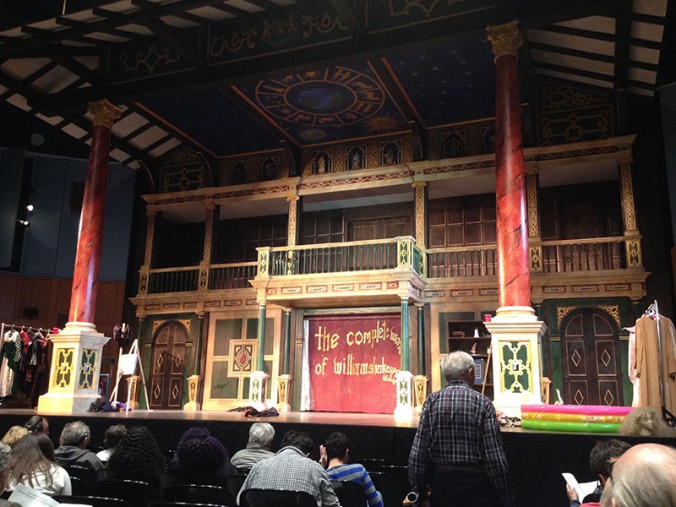
Hofstra’s New Globe Theater during an April 9 performance of The Complete Works of William Shakespeare (Abridged). Photo by CHRIS PERAINO
By Chris Peraino
Heidi Gleichauf, a junior at Hofstra University, punted Yorick’s skull into a crowd equal parts amused and startled. She committed this Shakespeare blasphemy under the same Latin phrase – “Totus mundus agit histrionem”- that The Bard himself performed beneath: “all the world’s a stage.”
The Complete Works of William Shakepeare (Abridged), a three-person comedy that morphs all of Shakespeare’s plays into a vaudeville of parody and slapstick devoid of a fourth wall, concluded the inaugural season of Hofstra’s newly erected Globe Theater replica last Sunday.
“Working on the Globe is like practical application of the training we get in Hofstra’s drama program,” Gleichauf said. “To me, it’s the difference between seeing photos of a landmark in a history class and going to see it in person. Knowing that we have access to the most accurate representation of the Globe in the country is really exciting.”
The design and construction of the replica was spearheaded by David Henderson, Associate Professor of Drama and Dance at Hofstra University in 2016. The stage is the closest American reproduction of the Globe Theater, Shakespeare’s performative stomping ground.
For over 50 years, Hofstra hosted an annual Shakespeare Festival on its original Globe replica until the structure was decommissioned in 2008 in light of new findings that deemed it historically inaccurate. Hofstra’s original had been designed by former Hofstra University president John Cranford Adams and was first erected in 1951.
“The administration had been a little bit perturbed that we had closed the other one down,” Henderson said. “But we were like, ‘you wouldn’t ask a chemistry department to use a 1950’s textbook.’ And so we’re teaching the wrong thing here.”
Since Adams’ original design, two key discoveries have been made: a piece of London’s Rose Theater, an Elizabethan contemporary of the Globe, as well as a piece of the Globe’s foundation, uncovered by parking lot construction. With them, researchers concluded that the original Globe was 20-sided. From a distance, this feigns a circle, a shape Adams said could not be built out of 17th century timber.
Henderson and researchers at London’s current theater believe that the original Globe was akin to a “jewel box,” full of bright imagery. This theory is supported by the few descriptions of Elizabethan playhouses that still exist.
But the actual content of the Globe’s imagery is not known; Henderson garnered inspiration for his images, which include Atlas bearing the globe on shoulders, lion crests and a lineage of Classical figures, by visiting 17th century English houses that still bear their original interior depictions.
“There’s certain rules you have to follow in terms of classical style, classical proportions and classical color scheme,” he said.
The rest is conjecture. “Other than that, it was just kind of what I wanted.”
Fittingly, the new theater ushered in a new era the same way the old theater concluded one: with a rendition of Hamlet.
“In period productions on the globe, like Hamlet earlier this semester, you don’t even have the help of lighting,” Gleichauf said. “You have to suspend your disbelief more than you might using a more traditional set because scene changes or changes of location are dictated purely by what part of the stage you’re using,”
The theater adds somewhat of a minimalist effect. Hofstra opts not to use any extraneous lights beyond stage lights, to mimic the original Globe Theater. Actors have to rely on their vocal projection to create scenery where there largely is none. Simply beginning a play without providing lighting or music cues for the audience can be tricky.
“The most difficult thing was the transition from the rehearsal room onto the stage, and trying to make sure our movements and voices were strong enough to carry out into the space,” Gleichauf said. “So not so much being exposed, but quite the opposite – how to be sure you are matching the grandeur of the space.”
But of course, the actors are not entirely on their own.
“They’re helped by Shakespeare,” Henderson said. “He wrote into the plays a moment that begins the play and things like that. It’s kind of like ‘oh that’s why this in here.’”
For at least two more years, the New Globe will be a staple for Hofstra’s Shakespeare Festivals. Drama staff are still deliberating on its frequency there afterward. Shakespeare lends way to a flurry of interpretations, some of which (modern dance, say) do not bode well with the stage.

